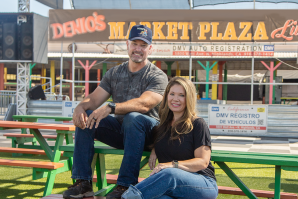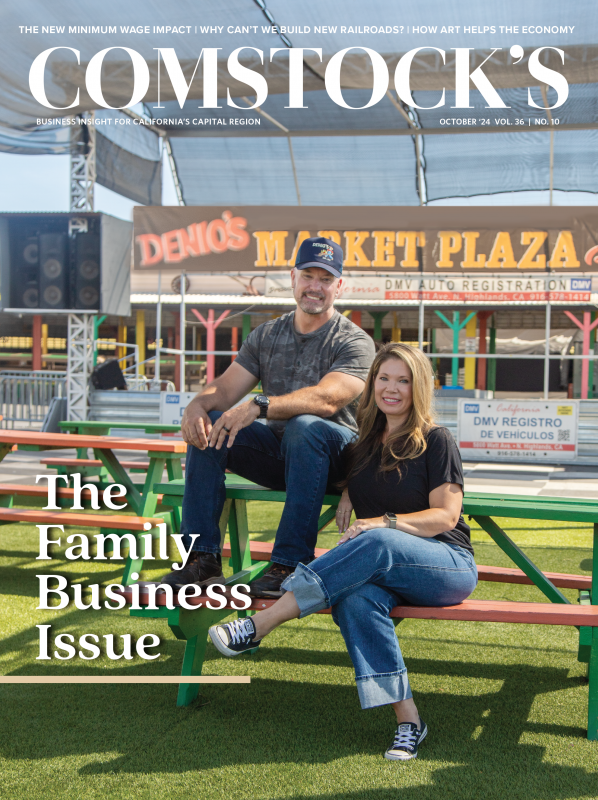In April, Joe Thompson, founder of Crisp Catering and co-owner with his wife of the Gold Rush Grille in downtown Sacramento, was finally starting to take a salary after paying off pandemic-related debt. But that month, four of his nine workers asked for a paycheck bump to $20 an hour because they’d seen news of the statewide fast-food minimum wage hike that took effect April 1.
All of Thompson’s staff were already above the state minimum of $16 an hour, and their working conditions are better than in fast food, says Thompson: They get regular 40-hour weeks Monday to Friday and are done by 2:30 every afternoon.
He wanted to keep his workers, so he gave them the boost. But it wasn’t just those four: Others already making more than $20 an hour wanted an increase too, so the change raised the wage structure for the whole business. In the end, he lost only one employee, who went to McDonald’s and ended up making less money because he got fewer hours, says Thompson.
The casualty was Thompson’s paycheck. The rough guideline used to be 30 percent overhead, 30 percent labor and 30 percent food, leaving 10 percent profit, he says. Now labor and food have each gone to 35, and overhead is up also. “Next thing you know, you’re at 103 or 105 percent of every dollar that comes in,” he says. He’s looked at self-serve kiosks — not to replace current staff but to avoid hiring new ones when they leave — but they run $200,000 and would take a year and a half to pay off, he says.
“We had a very short time to react. If the governor and legislators would have said, ‘You know what, we want you to pay 20 bucks an hour, but we want you to raise it $1 a year over four years,’ we would have all figured out how to do that.” Dennis Graspointner, owner, 23 McDonalds restaurants
After a grand bargain last September between the Service Employees International Union California, state legislators and restaurant owners, the $20 minimum wage for fast-food workers is here, signed into law by Gov. Gavin Newsom. The new rate is the highest minimum rate of any state in the country, overtaking Washington, D.C., at $17.50 an hour.
Negotiators for fast-food restaurants made the deal, which raised the fast-food minimum from $16 to $20 in one go, to avoid passage of a legislative provision that would have put both franchise or corporations and their franchisees legally on the hook for violating labor and other state and local laws. At the time, those violations were the responsibility of franchisees alone.
As economists and advocates debate the merits, the experiences of restaurant owners in the region offer some evidence of what happens in practice. Thompson’s business isn’t covered by the new law, but his case illustrates its possible ripple effects. Business leaders and owners in the region say the impact is far reaching, effectively raising the minimum for everyone.
Three sides of the wage debate
Proponents point to studies indicating that raising the minimum
wage doesn’t cause layoffs. That’s because restaurants’ market
power has allowed them to underpay fast-food workers for years,
UC Berkeley economist Michael Reich and fellow economist Justin
Wiltshire argued in an April article. The fast-food hike simply
rebalances that differential and will raise both pay and
employment, they predict.
Workers have long struggled to afford California’s cost of
living. The California Fast Food Workers Union didn’t respond to
multiple Comstock’s requests for comment or an interview with an
affected worker.
But last September, Los Angeles fast-food worker Angelica Hernandez, who was making just over $18 an hour after working at McDonald’s for 19 years, told a CalMatters reporter that at times she’d lived with her children and husband in a car or a cheap hotel that had cockroaches. “Sometimes I didn’t have enough to feed my children,” she said. Jack-in-the-Box worker Anneisha Williams, making $17 an hour, said the increase might keep her from eviction and maybe even someday let her take her kids to Disneyland.
On the other side are UCLA economist Lee Ohanian and others who say the hike will price out entry-level, immigrant and sporadic workers who’d otherwise get hired at the lower wage. He cites research that looks at longer-term effects, such as a 2015 study finding that a 10 percent rise in the minimum wage produced a 2.5-percent fall in employment after six years.
On a third side is at least one DC-based think tank, the Niskanen Center, that in July suggested states cut poverty not primarily through minimum wage hikes but state-run refundable child tax credits. Those, it argues, avoid negative employment effects that might accompany mandatory increases in the hourly minimum wage.
Inside a local McDonald’s
Dennis Graspointner can tell you what’s happened with stores he owns. He started in the 1970s working at McDonald’s to put himself through Sac State and eventually was promoted to management.
When he was 28, the company recommended him for a franchise in Turlock, and he moved there in 1979 to take over. Now he owns five McDonald’s in Sacramento and 23 overall, with two more under construction, and employs about 1,400 people.
The April 1 hike raised his payroll costs by $4 to $5 million, he says. But related costs added 15 to 20 percent more. His workers’ compensation bill is 25 percent higher since workers’ comp is based on payroll. His employer match on payroll taxes — Social Security, unemployment and others — has risen for the same reason.
To compensate, he’s cut worker hours by scaling back employee training and meetings, opening dining rooms later and closing them earlier. He’s reluctantly considering reducing the 25 percent match he offers on employee 401(k) plans and the $5,000 scholarships that help employees attend college.
“All of our independent restaurants are feeling the crunch. The fallout from this is just beginning, and it will spread to other industries.”Laurel Brent-Bumb, CEO, El Dorado County Chamber of Commerce
And he’s raised prices by about 10 percent in the last year — almost half of that due to the increased labor costs since April 1, he says. The higher wage has cut turnover dramatically — from about 60 to 10 percent — which lowered his training costs, but the savings don’t begin to make up for the increased payroll, he says.
One problem was the speed of the change. “We had a very short time to react,” says Graspointner. “If the governor and legislators would have said, ‘You know what, we want you to pay 20 bucks an hour, but we want you to raise it $1 a year over four years,’ we would have all figured out how to do that.”
The Newsom administration vigorously disagrees with those who say the change has depressed employment, pointing to U.S. Bureau of Labor Statistics data showing that the number of fast-food jobs grew by 11,000 from April to July. The longer-term numbers at first glance appear even better: From January to July the state gained almost 26,000 fast-food jobs. “Despite those who peddled lies about how this would doom the industry, California’s economy and workers are again proving them wrong,” the governor said in an Aug. 20 statement.
But comparisons with past years matter. In the three years preceding the pandemic — 2017 to 2019 — the state gained an average of more than 35,000 fast-food jobs from January to July. That is, fast-food employment growth in those periods was almost 2 percentage points higher in those years than in 2024.
The numbers for the Sacramento area— an area that the Bureau of Labor Statistics defines as El Dorado, Placer, Sacramento and Yolo counties — show a somewhat worse picture. From January to July 2024, the data show the region adding no fast-food jobs at all. By contrast, from 2017 through 2019, the region added almost 2,400 fast-food jobs on average from January to July.
And between October 2023 and July 2024 — a period that captures changes restaurants might have made to plan for the wage hike — the region lost 1,500 fast-food jobs, a period when it added 7,100 jobs overall. In those same nine months in 2017, 2018 and 2019, the region gained an average of almost 1,700 fast-food jobs.
Still, those data represent only a few months of experience under the new wage structure, and the impact might depend on where you look. In expensive areas like Truckee and Sacramento, the effects weren’t large because employers have long had to pay $18 to $20 an hour to attract entry-level workers, says Jessica Penman, president and CEO of Truckee’s Chamber of Commerce.
And Sacramento Chamber President and CEO Robert Heidt says some restaurants that are chamber partners and members already paid a higher rate. “I’d say that we have not had a large number of businesses call, reach out, talk to us about it,” he says. Loomis Basin Chamber Director K.D. Molnar says by email that her town has only three fast-food outlets and that one local restaurant owner not subject to the wage change said her employees have stuck with her.
By contrast, El Dorado County chamber CEO Laurel Brent-Bumb says the fast-food hike is rippling out to employers not subject to the new law. “All of our independent restaurants are feeling the crunch,” she says. “The fallout from this is just beginning, and it will spread to other industries.”
Likewise, employers in Citrus Heights are feeling the pressure to pay $20 or risk losing staff to fast food, says chamber executive director Sheri Merrick. The city’s parks and recreation department can’t afford to pay that rate to kids who are lifeguards, so they had trouble hiring them, she says. “It’s definitely a crisis,” she adds.
Erik Freeman, CEO and CFO of Jimboy’s Tacos, which has 40
restaurants in California and Reno, says the company strives for
good relationships and offers generous benefits for staff that
they can’t get at other fast-food companies.

What are the options?
For all that, businesses that survive might stand to gain. Erik Freeman is CEO and CFO of Jimboy’s Tacos, based in Folsom. The company has 40 California and Nevada locations in total, so the new law — which affects only those with at least 60 — didn’t apply. Freeman thought they’d lose employees unless they raised their wages to match.
But that hasn’t happened, because the company puts a premium on good relationships with staff — for example, adjusting hours for those who have kids or have a birthday coming up. “A small business can’t compete with big-box brands on wages, and the way to overcome that is good employee relationships,” says Freeman.
If the new law takes out some restaurants, Freeman hopes to fill the vacated space. “Our goal is to pick up those customers,” he says. “There are customers who are starting to compare us to the bigger brands and saying that we’re the better deal.”
Crisp Catering’s Thompson is considering a different route: retirement. “When you grow up in this industry, owning a restaurant is your dream,” he says. “But I’m getting up there in age, and this increase is making it really hard to want to continue.”
Recommended For You

What’s Holding Up Valley Rail?
The need and the plan are there, but bureaucracy once again slows progress
The project has been caught in spiraling delays, and launch dates have been pushed back to 2030. The San Jose Regional Rail Commission broke ground on just one of the half dozen proposed new stations as of late summer 2024.

The Value of Art
4 years out of the pandemic, Sacramento’s arts scene brings in tourism and tax dollars
A 2022 study conducted by Americans for the Arts in partnership with Sacramento Alliance for Regional Arts found that nonprofit arts- and culture-related activities in Sacramento County injected over $241 million into the local economy.

Is Our Future Tied to the Tracks? with James Stout
PODCAST EPISODE: Journalist James Stout delves into his latest feature for Comstock’s “What’s Holding Up Valley Rail?” where he investigated delays in railway expansion throughout the Central Valley. We discuss the hurdles that are baked into the system, changing attitudes towards public transit and whether hopping on a train might be more commonplace in future America.

Shining Lights
Hobrecht Lighting and Lofings Lighting have longevity while competitors have come and gone
At a time when anyone can order lighting fixtures off Amazon or wander the aisles of Home Depot or Lowe’s and select something readily available and cheap, visiting Hobrecht or Lofings can feel like a trip to a different era. Still, there’s a story worth telling connected to each of these Sacramento stores which shows how family businesses can endure even in changing times.

Roseville’s Unique Shopping and Entertainment Gathering Place
Family business spotlight: The Denio family embraces the future while honoring their roots
Eric and Tracy Denio remember Roseville before it was a suburban powerhouse — back when their childhood days were spent roaming among fields, ranches, ponds and gravel pits. Flash forward to today, and Denio’s Farmers Market & Swap Meet is surrounded by oceans of homes and shopping centers that span for miles in every direction. But one thing that hasn’t changed is its ethos.

A Pioneer in Organic Farming
Family business spotlight: Pleasant Grove Farms in Sutter County grows popcorn, wheat and rice the natural way
Driving along a country road in rural Sutter County and seeing endless rows of corn, you can’t help but think of the movie “Field of Dreams.” The Sills family decided to build their dream eight decades ago. Pleasant Grove Farms, a family-owned, certified organic grain and bean farm, has been growing corn and other crops for nearly 80 years.

A Stockton Institution
Family business spotlight: The Bank of Stockton has been operating for 157 years
Founded in 1867, Bank of Stockton is the oldest bank in California still operating under its original charter. This longevity and continuity in serving communities with Bank of Stockton branches — as of November, there will be 21 locations throughout the Central Valley — sets this family business apart.

A Fire in the Sky
Family business spotlight: From Macy’s Fourth of July to the Space Needle, Pyro Spectaculars produces more than 400 fireworks shows a year
The show producer opens his laptop, and with a touch of the keyboard the magic begins. Music swells, and a spectacular vision of multicolor sparkling flowers explodes in the night sky, along with golden starbursts and shiny cascading waterfalls.




